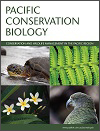Pacific Conservation Biology
Volume 31
Number 4 2025
Fire history responses were measured for 17 orchids in south-western Australian urban banksia woodland. Some were highly tolerant and flowered more after fire, but others were less common or absent, as explained by their biology. Orchid diversity increased for four decades after fire. Fire must be carefully managed in orchid habitats.
Attitudes towards environmental protection is important but can be difficult to change and lack of knowledge can provide barriers. This study measures people’s knowledge of local deforestation and tests how this and other strategies can change these attitudes. Results suggest knowledge is low, but attitudes can be changed by providing information.
Australia’s reptiles are declining but farms hold the key to saving them. This review highlights how agricultural practices have largely overlooked reptiles, despite their sensitivity to habitat change. By synthesising decades of research, this paper provides practical strategies for landholders to make farming wildlife-friendly, with global implications for biodiversity conservation.
This Pacific-centric perspective piece outlines strategies aimed at dismantling systemic barriers faced by Pacific researchers when designing and conducting research, writing manuscripts and publishing in the academic literature. We highlight pathways for greater inclusion of Pacific scholars in academic publishing to which Global North researchers, academic journals and funding agencies can contribute.
A subspecies of Eld’s deer (Rucervus eldii siamensis) has a strong-hold in Cambodia; however, populations are small. We used camera traps during the dry season to assess if this sampling tool could be used to estimate population size. We designed a methodology to successfully produce a population estimate that can be used to monitor the status of this subspecies and inform conservation management.
Sharks are threatened with extinction globally due to overfishing driven by trade. However, there is little understanding on transit and potential illegal trade of shark products in Oceania, including the contribution of Australia and Aotearoa/New Zealand, considering the proximity to the ‘hub’ of the shark fin trade in Southeast Asia. Further investigating links between countries and improving recorded species information are crucial to support monitoring and regulation of the trade of sharks and endangered species.
Feral cats (Felis catus) predated Carnaby’s cockatoo (Zanda latirostris) nesting adult females, their nestlings, and eggs during a study in remnant woodland in the northern wheatbelt of Western Australia. The predation impact on annual cockatoo nesting effort ranged from 5.2 to 24.1%, suggesting that cats are a significant threat by reducing the survival of adult breeding females and recruitment of fledglings.
Camera traps offer a cost-effective way to track wildlife but the large amounts of data camera traps produce hinders their usage. This barrier can be overcome using machine learning to automatically classify data and generate population density estimates. This approach could enable widespread wildlife monitoring to assess biodiversity trends.
French Pacific Island territories are home to unique biodiversity, threatened by invasive rodents. This study reviews 85 eradication projects across 77 islands since 1982. Adopting a strategic approach with clear island prioritisation and enhanced local capacities is essential to achieving sustainable eradications and protecting the French Pacific Islands unique biodiversity.
Walking sharks (Hemiscyllium spp.) are endemic species in the Indo-Pacific region. Threatened by fishing, habitat loss, and the aquarium trade, they received legal protection in Indonesia in 2023. However, further conservation actions such as expanding Marine Protected Areas (MPAs), habitat restoration, and captive breeding are essential for their long-term survival and sustainable management.
Understanding bird movements is critical for conserving their populations and habitats. We satellite-tracked the movements of 18 juvenile egrets (Ardea spp.), describing where, when, and how quickly they flew. This included tracking a non-stop flight from Australia to Papua New Guinea that took approximately 38 h. This information is useful for prioritisation of management resources for wetlands and waterbirds.
Little is known about how landscape scale features influence frog distribution; this is especially the case for the vulnerable frog species Mixophyes iteratus. This study surveyed M. iteratus occurrence and counts over the Tweed Valley of northern New South Wales, Australia to determine if there was a relationship with landscape features. Occurrence was biased towards the western part of the Tweed Valley and counts were higher in conservation reserves. Conservation efforts should focus on micro-habitat features in areas with low- to mid-count predictions.





